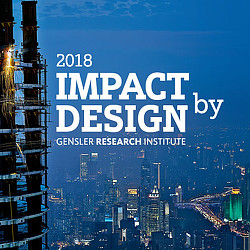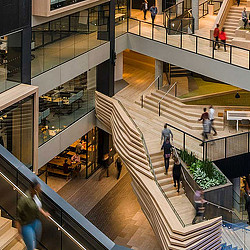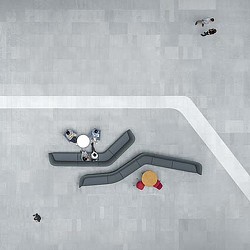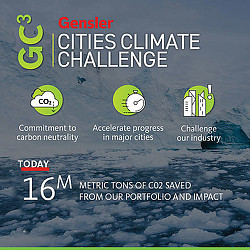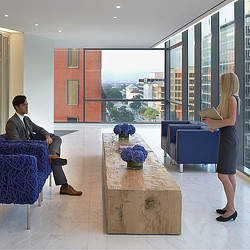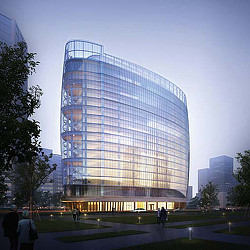The effects of climate change are threatening cities and businesses around the globe. Increasingly frequent wildfires, droughts, flooding, and rising sea levels are displacing populations and impacting supply chains, both of which are disrupting social, cultural, and economic norms.
Buildings contribute nearly 40% of global greenhouse gas emissions, according to Architecture 2030. Of this amount, 28% is due to building operations, and 11% is due to building materials and construction, so incorporating resilient design strategies into office building and workplace design can have a big impact. At Gensler, we embrace resilience more broadly to suggest that design constantly evolves, adapting to and preparing for a changing world. Here, we take a look at five key design elements that will be a part of tomorrow’s resilient workplace.
VERTICAL ECOLOGY FOR OFFICE BUILDINGS
One promising solution for tall office buildings is vertical ecology, which borrows heavily from the concept of biophilia — the notion that the more humans connect with other living systems, the more they benefit. Studies have shown that biophilic elements in the workplace can reduce absenteeism and increase worker productivity, while daylight can boost melatonin production and enhance sleep. Viewing fractal patterns and shapes that mimic natural forms can reduce stress by up to 60%, according to a University of Oregon study. And since vegetation can absorb toxins and pollutants, biophilic design can vastly improve air quality.
Gensler’s design for China’s Zhuhai Huace International Plaza merges two towers into a single form with a vertical atrium system and sky and terraced gardens that create a breathing envelope to bring fresh air into the building. With louvers for air flow and plant growth, Huace Plaza’s vertical ecology embraces biophilic design to improve air quality and enhance occupants’ health and well-being.

1. VERTICAL ECOLOGY: Zhuhai Huace International Plaza, Zhuhai, China.
Twin towers create a vertical ecology leveraging passive and natural ventilation strategies. A vertical atrium system with sky and terraced gardens creates a breathing envelope to bring fresh air into the building.

2. ENERGY-SAVING FACADES: Harbin Bank Headquarters, Beijing.
A single-glazed outer skin and a double-glazed inner skin form a cavity, which works like a thermal duvet to insulate the building year-round. The climate-responsive facade maximizes daylight and energy efficiency while minimizing harmful particulates.
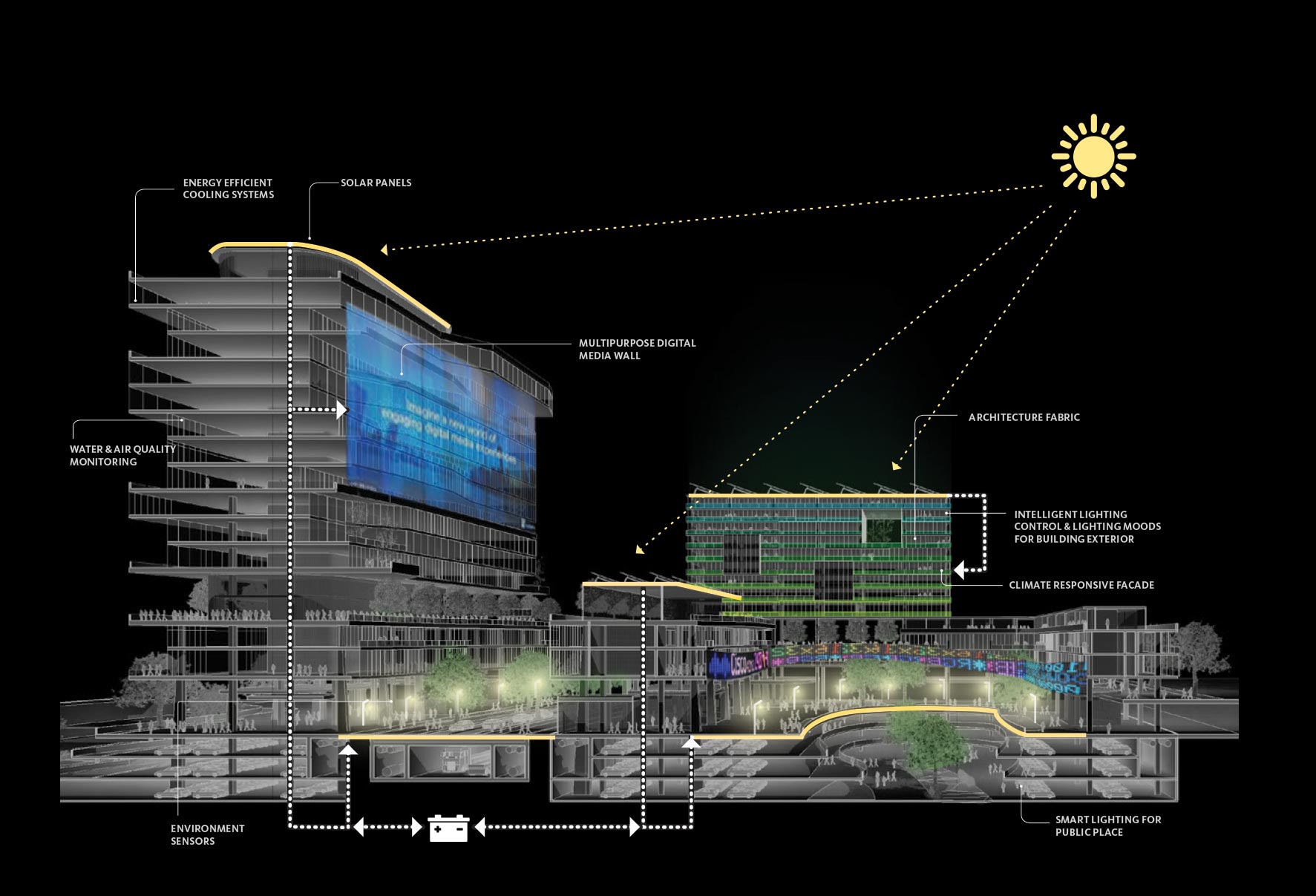
3. INTELLIGENT BUILDING CONTROLS: Cisco Smart City, Guangzhou, China.
Gensler’s master plan for this smart city integrates technology across all scales, from buildings to infrastructure. The connected environment optimizes energy, water, and light efficiency based on real-time conditions. Systems also monitor temperature, pollution, and waste management.

4. REGENERATIVE AND RESTORATIVE BUILDINGS: Etsy, Brooklyn, New York.
This Living Building Challenge (LBC) Petal-certified building strives to be a regenerative ecosystem; it’s not just a self-sustaining workplace but also a space that gives back to its neighborhood. Every component met LBC requirements for being non-toxic, sustainable, and locally sourced.

5. ADAPTATION AND REUSE: UPCycle, Austin, Texas. This repositioned warehouse reuses 95% of building materials to create vibrant, creative workspace.
ENERGY-SAVING FACADES
According to the International Energy Agency, buildings consume 50% of the world’s energy. To mitigate this consumption, we can add climate-responsive facades to office buildings and workplace projects. These adaptive envelopes can mitigate solar heat gain, reduce energy used to cool and heat the building, optimize daylighting and shading, and improve air quality while also reducing energy consumption. In megacities such as Beijing, where toxic air levels can exceed 300 AQI on the Environmental Protection Agency’s Air Quality Index, healthy interiors and buildings are critical contributions to the health of the community at large.
For Harbin Bank’s Beijing headquarters, a climate-responsive facade maximizes daylight and energy efficiency while minimizing harmful particulates. A single-glazed outer skin and a double-glazed inner skin form a cavity, which acts like a thermal duvet to insulate the building year-round.

INTELLIGENT BUILDING CONTROLS
Another way we can help lower energy and water costs is by making buildings more intelligent. By leveraging real-time data, intelligent building controls can lower energy consumption and make buildings safer and healthier. Sensor technology and IoT-enabled devices will allow individuals to adjust temperature, air, lighting, and acoustics.
Gensler’s master plan for the Cisco Smart City in Guangzhou, China, integrates technology across all scales, from buildings to infrastructure. The connected environment optimizes energy, water, and light efficiency based on real-time conditions. Systems also monitor temperature, pollution, and waste management.

REGENERATIVE AND RESTORATIVE BUILDINGS
Our design increasingly focuses on elevating the life cycle of buildings so that they can positively impact the communities they’re in. This approach goes beyond conventional high-performance practices of water and energy efficiency to integrate design more closely with local communities and natural systems. There are net zero or net positive energy buildings, producing on-site electricity through built-in solar and wind generators that can augment an overwhelmed local grid. Or structures with rooftop gardens to capture and filter rainwater to service all their non-potable needs, thereby lowering the demand on city water supply and stormwater treatment. Etsy’s Living Building Challenge Petal–certified Brooklyn headquarters strives to be a regenerative ecosystem; it’s not just a self-sustaining workplace but also a space that gives back to its neighborhood.
ADAPTATION AND REUSE
Often, the single greatest decision to minimize environmental impact is to reuse buildings, spaces, and materials that already exist. The National Trust for Historic Preservation’s Green Lab found that it can take up to 80 years before the energy-efficient features of new buildings begin to make up for the damage their construction has caused to the environment. Consequently, it’s imperative that we develop strategies to improve the performance of existing buildings without tearing them down. A great example is UPCycle, a warehouse in Austin repositioned into a creative office space, which reused 95% of the existing structure.
A resilient workplace is one of the first steps we can take in creating the cities of the future. When done with smart design strategies, a resilient workplace can improve quality of life, productivity, resource efficiency, and operating costs all at once.

